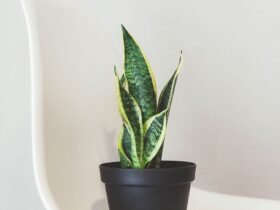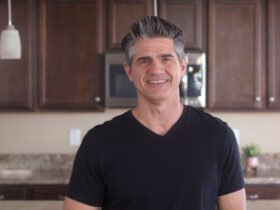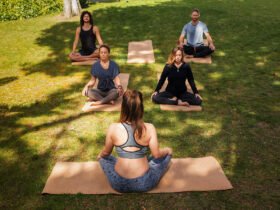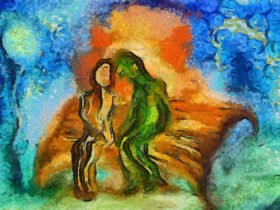Presence is meditation in motion. It is the practice of bringing mindfulness into the activities of daily life. We can practice the art of being here, now, while waiting in a long grocery store line, changing a baby’s diaper, or sitting in traffic.
Presence involves a simple yet incredible shift—from the ordinary state of mind wandering to bringing our attention to the experience of what is happening right now. You can make this shift anytime, anywhere.
Why develop this habit? Spiritual leaders and philosophers have attempted to answer this question for thousands of years. And yet Ferris Bueller (the impetuous high school student from the classic 1986 film) might just have the best answer: “Life moves pretty fast,” he warned. “If you don’t stop and look around for a while, you might miss it.”
He’s right. Life without presence moves pretty fast. When we wake up, go to work, and do the other things we need to do, we often operate on autopilot; the days fly by, as do the weeks, months, and years. In fact, scientists have confirmed that this experience of time “flying by” increases with age. With each passing year, the novelty of life diminishes and our perception of time accelerates.
When we wake up, go to work, and do the other things we need to do, we often operate on autopilot; the days fly by, as do the weeks, months, and years.
This has led the mindfulness teacher Jon Kabat-Zinn to argue that if you really want to live a longer life, presence—not drugs, healthy eating, or any other strategy—is the best solution. You may not actually live longer in terms of calendar time, but your experience of life and your perception of time will expand. The days, months, and years can be richer, more meaningful, and more fully lived.
Appreciating the fall leaves, listening to the crunch under your feet as you walk on the winter snow, smelling the scents of flowers or fresh-cut grass, feeling the warmth of the summer sun—these simple acts of presence slow life down. They help us go through each day feeling more alive, awake, and content.
There are other benefits, too. Presence doesn’t simply change the quality of being. It can also transform the quality of what you do, leading to greater creative flow, enhanced relationships, and increased productivity at home and at work.
Through developing the habit of presence, we can get in touch with the fundamental wonder of what it is to be alive, and even the most ordinary moments become extraordinary.
How to Stay in the Present Moment
But it’s not that simple. There’s also something quite mysterious about this moment. It’s not like the past, which stretches infinitely behind us. It’s also not like the future, which stretches infinitely ahead. In fact, the moment you try to capture it, it’s gone. It becomes just another part of the past.
Philosophers have strived to define the present moment. While some have seen it as almost nonexistent—fleeting and infinitely thin—others saw it as having infinite depth.
In fact, the ancient Greeks identified three ways that opening to the present moment increases the depth of our experience and productive possibilities of each moment. First, when we fully experience what is here and now, we no longer postpone what we most want. We live our fullest life now. The philosopher Epicurus captures this ethos of urgency:
“We are only born once—twice is not allowed—and it is necessary that we shall be no more, for all eternity; and yet you, who are not master of tomorrow, you keep on putting off your joy?”
This is something many of us have experienced. Have you ever heard the shocking and sad news that someone close to you has died and then thought, Am I living life as fully and as presently possible? Death makes us acutely aware of our aliveness and the preciousness of each moment.
Second, attending to the present moment enables us to take advantage of the full range of possibilities that exist in each moment. This helps us adapt to even the most challenging situations. If you’re stuck at the airport with a long delay, you can let your mind swirl with thoughts about the past and future: I should have taken the earlier flight or I am going to be so late and tired. Or you can experience the power of the present moment and take advantage of the new possibilities available to you as a result of the delay: go for a brisk walk through the concourse, read for pleasure, eat a meal, or catch up with friends on the phone.
When we manage to enter the razor-thin moment of presence, something amazing happens: anxieties and resentments dissolve. We experience more ease, calm, and peace.
Being present opens up a third possibility: happiness and well-being. When we spend the day traveling through the past and future, we tend to get trapped in a host of negative emotions, from anxiety to irritation to resentment. The Epicurean school of ancient Greek thought used sayings like this: “Senseless people live in hope for the future, and since this cannot be certain, they are consumed by fear and anxiety.”
When we manage to enter the razor-thin moment of presence, something amazing happens: anxieties and resentments dissolve. We experience more ease, calm, and peace. In short, we experience more well-being. What is the present moment? This almost sounds like a trick question. Everyone knows that the present moment is what’s happening now. The wind in the trees, the touch of fabric against your skin, your dog brushing up against your leg.
The Science and Practice of Presence
The science on this is clear. Spending more time in the present moment leads to greater happiness. A Harvard University study conducted in 2010 by Matthew A. Killingsworth and Daniel T. Gilbert, for example, revealed that happiness is inversely related to mind wandering—the amount of time that we spend time traveling through thoughts about past and future.
Killingsworth and Gilbert discovered that most of us spend a lot of time mind wandering—distracted from the present moment. In fact, the average person spends 47 percent of the day mind wandering: thinking about something other than his or her present activity.
Their key insight, however, wasn’t just that our minds wander. It was the link between presence and happiness. Killingsworth concluded, “How often our minds leave the present and where they tend to go is a better predictor of our happiness than the activities in which we are engaged.” In other words, this landmark study shows that one of the keys to happiness lies in simply redirecting our attention from mind wandering and distraction to what’s happening right here, right now in the present moment.
A Practice to Shift Your Attention to the Present Moment
- Notice—see if you can become aware—each time you step into the shower.
- Shift your attention to the sights, sounds, and bodily sensations of the present moment. To do this, we recommend that you ground your feet and bring your attention to your breath. Use what we call the “4×4 breath” or the box breath—four counts in, four counts out, for four breaths. This move will help you begin building the habit of shifting your attention from mind wandering and stress to the present moment.
- Rewire—encode this experience deep into your memory by savoring it for just 15 to 30 seconds.
Quick Tips
- Do it every day: Practice presence every day and, if you forget to do it in the shower, practice presence during some other everyday life moment, such as walking up the stairs or starting your car.
- How to remember to do it: The most difficult thing about building this habit is remembering. To help you remember, we have developed a low-tech but extremely effective method. Put a sticker at eye level on your shower door. If you don’t want to use a sticker (or don’t have a shower door), you could use a piece of masking tape with “Presence” written on it. After a month or so, once the habit is ingrained, you may find that you no longer need it.
- How you know it’s working: After a couple of weeks or a month, you will likely start to notice that you no longer need to consciously remember to experience presence. It just starts to happen as you enter the shower. This is the magic moment of habit formation. It means that your brain has wired a new set of connections around this everyday activity.
- If you want more: If you have mastered the habit in the shower, try adding an advanced cue: stairs. Every time you walk up or down a flight of stairs, see if you can be present. This is a perfect time to feel the sensations in your feet or to bring your attention to the sights and sounds that occur as you step. This additional cue will take you even deeper into the experience of presence.
Adapted from Start Here: Master the Lifelong Habit of Wellbeing by Eric Langshur and Nate Klemp, PhD.
Mindfulness teacher Jason Gant reflects on a heartfelt memory when he was able to lean on his deep practice and mindfully take action. Read More
Reclaim the first few moments of your day by dedicating some time to morning meditation or an empowering routine. To help you get started, we’ve gathered our best tips on how to ease your mind and body into a new day. Read More
Tita Angangco, cofounder of The Centre for Mindfulness Studies, shares a loving-kindness meditation that serves as an ignition to spark change. Read More
















Leave a Reply